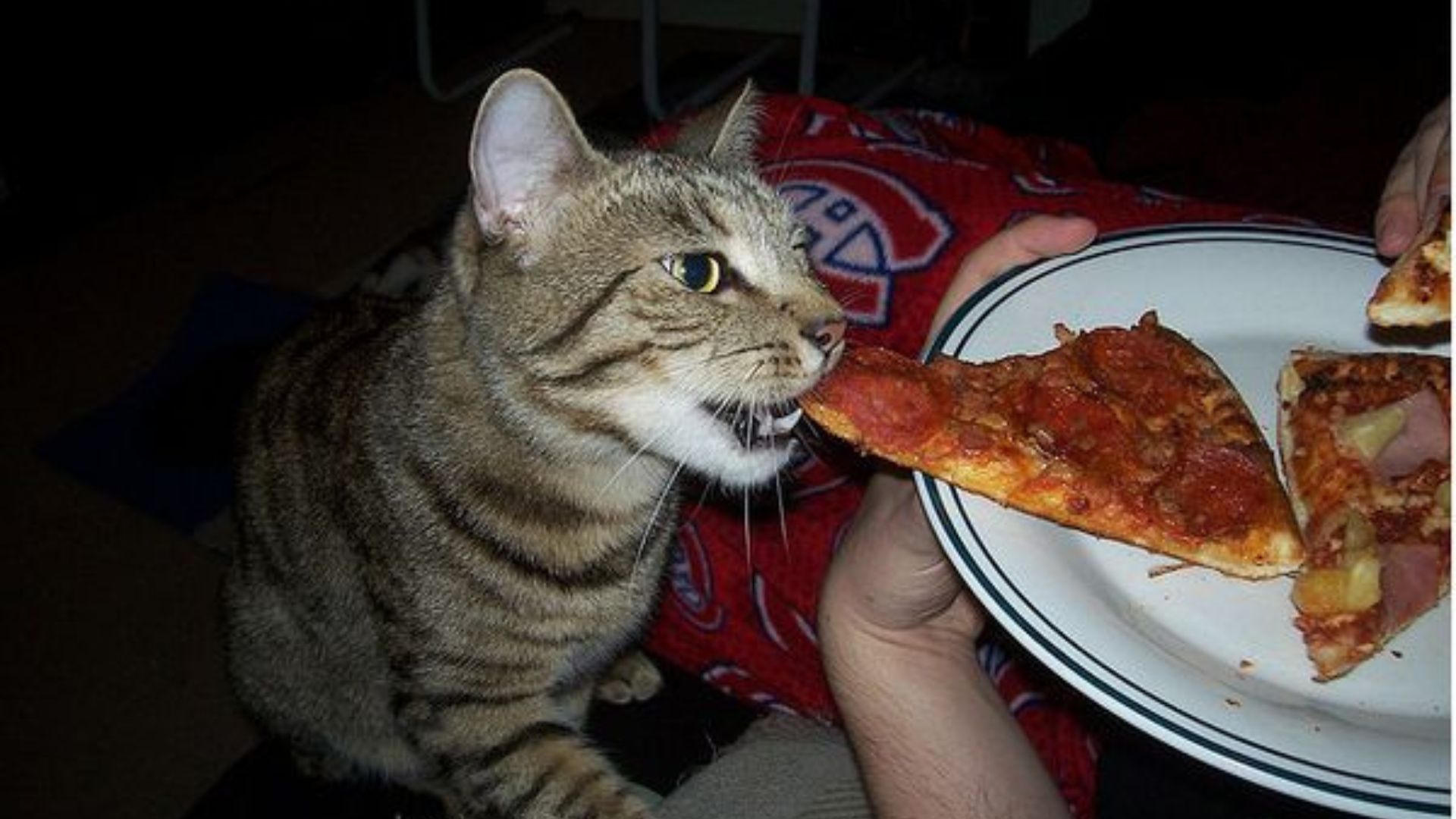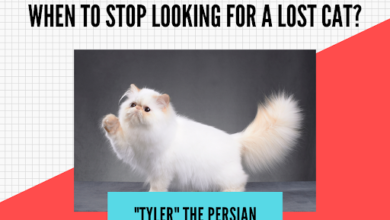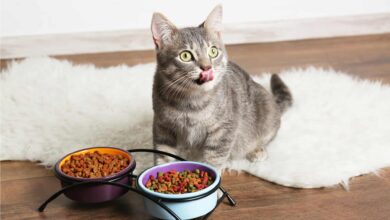Can Cats Eat Pepperoni? Let’s Find Out
Exploring the Feline Diet: Uncovering the Safety of Pepperoni for Cats

Pepperoni might smell tempting to your feline friend, but should you ever let, can cats eat pepperoni? The short answer is no – pepperoni can be very dangerous and unhealthy for cats.
Keep reading to understand why pepperoni and other human foods are risky for your cat’s health.
Cats have very different nutritional needs compared to humans. Their bodies are not designed to process many of the spices, preservatives, and fatty ingredients in human foods like pepperoni.
The high fat and sodium content can lead to severe gastrointestinal distress in cats. Even just a few bites of pepperoni can cause acute symptoms like vomiting, diarrhea, lethargy, and dehydration.
Long-term, a diet heavy in human foods like pepperoni may cause obesity, pancreatitis, heart disease, and other life-threatening conditions, Can Cats Eat Pepperoni?
Their small size and quick metabolisms require cat-tailored nutrition, not salty, fatty people’s snacks.
Myth vs Fact: Can Cats Really Eat Salami or Pepperoni?

Myth: It’s fine to give my cat occasional nibbles of salami or pepperoni as a treat.
Fact: No amount of pepperoni is safe for cats. The spices and high sodium levels can be toxic.
Myth: If I remove the casing, the meat part won’t be as dangerous.
Fact: Even the meat itself contains too much fat, salt, and spice for feline health.
Myth: A little won’t hurt them.
Fact: Just a few bites of pepperoni can cause gastrointestinal upset, vomiting, or diarrhea.
Why Is Pepperoni So Risky for Cats?
There are several key reasons why cats and pepperoni don’t mix:
- High Fat Content – Pepperoni has a very high-fat percentage, around 25-30%. Too much dietary fat can lead to feline obesity and pancreatitis.
- Spices and Seasonings – Onions, garlic, paprika, red pepper – cats’ digestive systems can’t handle these spices well. They may cause stomach upset.
- Sodium – Pepperoni is very high in salt, which cats shouldn’t consume in large amounts. Excess sodium is bad for the kidneys.
- Preservatives and Additives – The artificial flavors, colors, and preservatives may be carcinogens and toxins for cats.
- Can Cause Gastrointestinal Issues – The high fat, spices, and sodium overload from pepperoni can inflame a cat’s stomach and intestines. Vomiting, diarrhea, and constipation can result.
- May Lead to Pancreatitis – The high-fat content puts cats at risk for developing this extremely painful and potentially fatal condition.
If you notice any signs of illness like vomiting, lethargy, diarrhea, or loss of appetite after your cat eats something they shouldn’t, contact your vet immediately.
Catching pepperoni poisoning early greatly improves the chances of recovery.
Read More: Can Cats Eat Pancakes?
Healthier Alternatives to Pepperoni for Your Cat
Now that you know why pepperoni is off the table for cats, what human foods can kitties safely eat? There are some people-friendly foods that also fit into feline nutrition when given in moderation.
Lean meats like cooked chicken or turkey make excellent high-protein treats for cats. Just be sure to remove any bones, skin, or fatty bits first.
Canned tuna packed in water and boneless salmon provide healthy omega-3s without too much mercury risk. Hard-boiled or scrambled eggs are another great protein source but limited to just a bite or two.
For produce, stick to low-sodium fruits and veggies your cat may nibble on, like carrots, green beans, blueberries, or banana slices.
Avoid garlic, onions, and other toxic veggies. Introduce new foods gradually to avoid stomach upset.
Veterinarians Reveal the Top Human Food Cats Get Into
In a poll of veterinarians across the country, these were reported as the most common human foods cats accidentally or intentionally consume:
- String, tinsel, or dental floss (foreign body obstruction hazard)
- Chocolate (toxic to cats)
- Cheese and milk (may cause diarrhea)
- Grapes and raisins (can lead to kidney failure)
- Bread dough (risk of ethanol toxicity)
- Xylitol-containing foods like gum and candy (life-threateningly toxic for cats)
- Onions and garlic (damage red blood cells)
- Bacon and fatty meats (pancreatitis risk)
- Alcoholic drinks (extremely toxic)
- Coffee and tea (caffeine is unsafe for cats)
This poll reiterates some of the biggest people food hazards for cats. Be extra cautious keeping these items far from your curious cats.
Think Twice Before Sharing Table Scraps
It can be tempting to share tastes from your plate with begging feline companions at the table. But human food, especially in excess, carries health risks for cats.
Some key reasons vets caution against table scraps:
- Obesity – Even healthy human foods carry more calories than cats require. Table scraps can quickly lead to obesity.
- Nutritional Imbalances – A diet of people’s food lacks vital nutrients cats need while delivering excess fats, carbs, and sugars.
- Gastrointestinal Trouble – Rich or spicy foods may irritate cats’ stomachs and digestive tracts.
- Pancreatitis Risk – Fatty scraps put cats at risk for this painful, dangerous inflammation.
- Allergies – Cats may have food allergies or intolerances you are unaware of.
- Toxic Ingredients – Human food may contain toxic additives, spices, preservatives, etc.
For optimum feline health, feed only designated commercial cat food formulated for their needs. Avoid the temptation to share your plate, no matter how pleading your cat’s eyes may be!
Keeping Your Sneaky, Can Cats Eat Pepperoni?
Has your cat ever busted into the pantry or leaped onto the kitchen counter to steal human food? This common cat behavior stems from curiosity, food drive, and a powerful sense of smell.
While humorous, it can be dangerous if your cat gets into unsafe people’s foods. Here are some tips to cat-proof your kitchen.
Interesting Feline Diet Facts
Cats are obligate carnivores, meaning they need a meat-based diet, unlike omnivorous humans. Some key dietary differences include:
- Cats lack the carbohydrate digestion humans possess, so grain-heavy foods like bread or pasta are not well-tolerated.
- With a heightened sense of smell, cats detect enticing aromas of human food from far away. However, their taste buds are not receptive to sweet flavors.
- The feline liver has limited ability to metabolize plant toxins found in herbs, veggies, chocolate, etc. that are safe for humans.
- Cats require 2-3 times more protein than humans relative to their body weight to meet metabolic needs.
- A cat’s nutritional requirements fluctuate at various life stages, so it cannot thrive on “people food” alone.
Keep People’s Food Out of Paw Reach
The most direct way to keep cats from consuming unsafe human food is simply storing these items out of their reach. Tips include:
- Keep food in cabinets or pantries closed tight or latched shut
- Place trash cans inside closable cabinets instead of under sinks
- Don’t leave cooking food unattended on the counters or stove
- Put dirty dishes immediately in the dishwasher or sink, not the counter
- Store groceries like fruits or bread in the fridge right away
- Keep countertops cleared of food spills or cooking oils/grease
- Don’t feed cats table scraps during human mealtimes
Provide Approved Snacks as Alternatives
Even the most stubborn cats can be trained not to beg for human food. The key is providing them with appropriate, cat-safe alternatives:
- Place their regular meals or cat-approved treats in occupied spots on the counter during cooking times
- Invest in food puzzle toys you can put approved snacks into for mental stimulation
- Stuff and freeze special “kitty cakes” or snacks made with cat-safe ingredients
- Grow some cat-friendly “cat grass” for them to nibble on
- Offer an alternate water fountain away from the kitchen if they’re attracted to sink water
With patience and plenty of positive reinforcement, your sneaky feline will learn the kitchen is not their dining room! Never scold or punish a cat for counter-surfing, as they will not understand.
Simply redirect gently to an approved snack or toy instead to get your point across.



